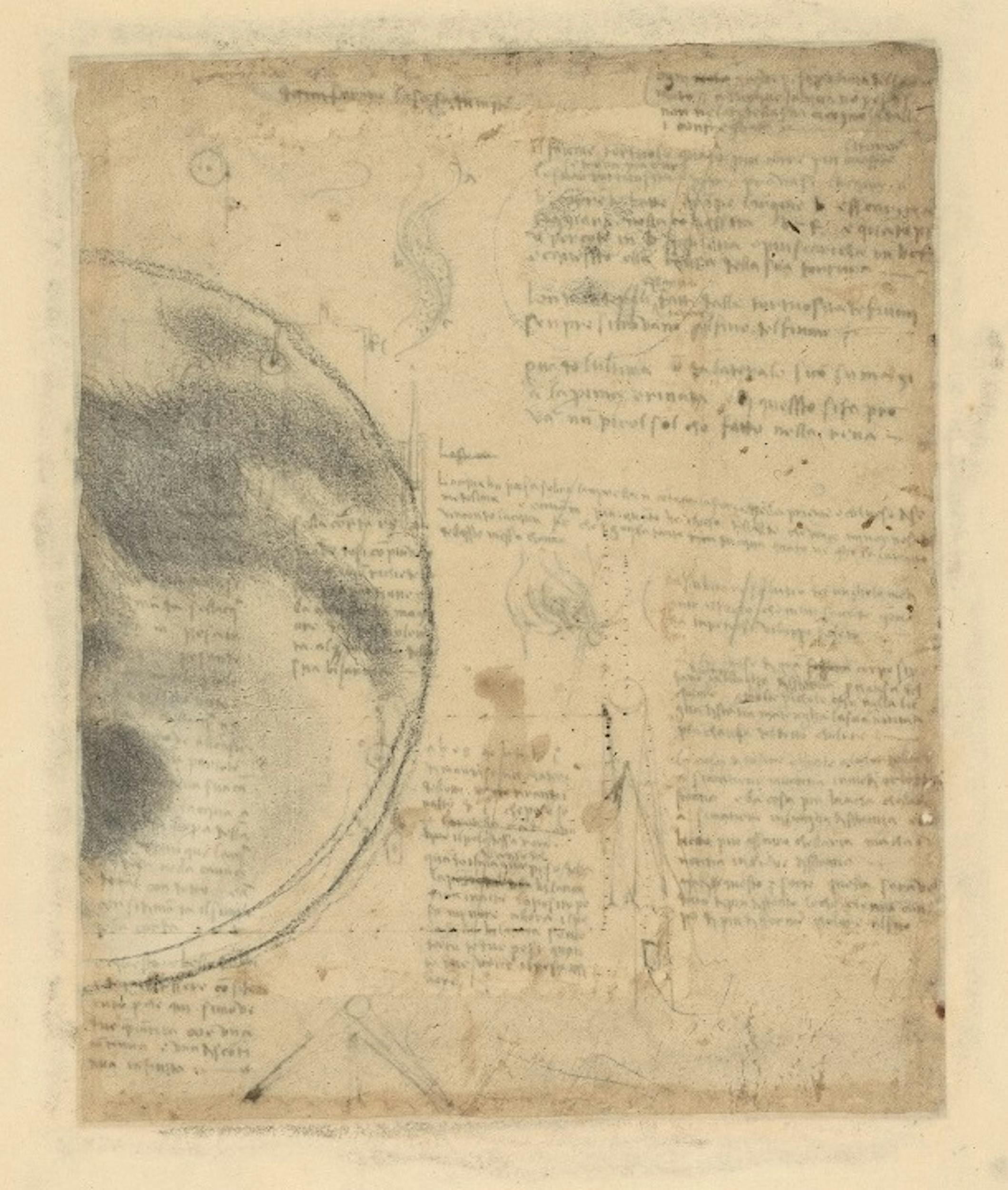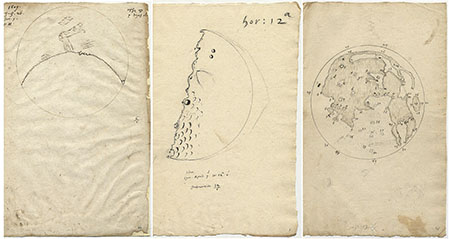The refracting and reflecting telescopes
Long before the examination of the Moon under many instruments, it was observed only through the naked eye. The drawing Cortex Atlanticus by Leonard da Vinci (1452-1519), at the Biblioteca Ambrosiana in Milan, presents a first sketch of the Moon, but still lacks precision. It is difficult to estimate the actual conditions from da Vinci’s observations and if he had any first form of assistance with optics.

Leonard de Vinci, Codice Atlantico, "La Lune" (f. 674v), 1513-1514. Crédits : Biblioteca Ambrosiana.
The first known observation of the Moon through a telescope was on August 1609. Galileo Galilei (1564-1642) did not earn the credit for this achievement, but to Thomas Harriot (1560-1621), an English astronomer, mathematician and cartographer. Harriot benefited from the first models of telescopes, and it has given him the ability to focus more on the details of the lunar surface’s outline, and the Moon’s topography (the division between the illuminated and dark hemispheres).[1]

Thomas Harriot, Dessins d'observation de la Lune, 1609-1611. Crédits : The Egremont Collection.
The father of this new invention has brought a rapid envy and interest in the scientific community. The progress in the field of optics and lenses has been growing notably during the end of the 16h century. The first astronomical telescopes are often attributed to two rival opticians: Zacharias Janssen (v. 1588- v. 1635) and Hans Lippershey (1570-1619), who are both Dutch.
Lippershey develops in his workshop a simple system: the eyepiece is made of a concave lens, thick on the edges and thinner on the center. On the oculars opposite extremity, there is a convex lens, which is the opposite: thicker in the center and thinner on the edges. The direct association between both lenses allows a larger and brighter image.[2]
By adapting this kind of instrument, four months after Harriot on November 1609, Galileo observes the Moon and draws a part of its surface. In 1610, his observations are included in a publication. His famous work Sidereus Nuncius, also known as Starry Messenger, becomes an instant success and introduces his name throughout Europe.
Afterward, other inventions are born, which are higher in precision. The increase of the focal lens offers images of great quality, but the manipulation of these new instruments are difficult due to their larger size. This is the case for Johannes Hevelius’ “celestial machine” (1611-1688). Located in Gdańsk (Dantzig), it is 46 meters long.
At the Paris Observatory, Jean-Dominique Cassini (1625-1712) assembles a tubeless refracting telescope, as it allows a greater focal length. With this new technique, he observes Saturn and discovers Huygens’ satellites (Japet, Rhéa, Thétis and Dioné), improves knowledge on the planets’ rotation and attempts to map the Moon.
Tubeless telescopes. Jacques Cassini, Theses mathematicae de optica…, 1691.
After a period featuring refracting telescopes, reflecting telescopes takes the lead, thanks to Isaac Newton’s (1642-1727) research. The telescope’s functioning differs from the refracting one. Adding a mirror allows images to be clearer by focusing the light on a unique position.
By the end of the 1660s, Adrien Auzout (1622-1691) and Jean Picard (1620-1682) invent a micrometer, which allows the precise measurement on the size of objects and their distance.[3] By perfecting this scientific tool, the German astronomers Tobias Mayer (1723-1762), Johann Hieronymus Schröter (1745-1816) and Wilhelm Gotthelf Lohrmann (1796-1840) will propose Lunar maps that are always more precise, during the 18th and 19th century.
Jacques Canivet, Micromètre, 1761.
In the search of a greater precision, it is important to point out J. H. Schröter’s (1745-1816) system that permits a direct transmission of observations through drawings by using a visible grid directly on the lens, and printed on paper for the execution of drawings. Somehow, it did not prevent him from a number of proportion errors.
The modern telescope takes its final form when Léon Foucault replaces the bronze mirrors for silver glass mirrors; having issues in terms of rapid oxidation and a low luminosity power in reflection. The Observatory of Paris keeps one of the first models of its telescopes, used notably for the first test of photographic images taken of the Moon by Charles Wolf (1827-1918).
Léon Foucault et Marc Secrétan, Télescope de Foucault, 1856.
In 1891, on Maurice Loewy’s (1833-1907) initiative, the installation of the “grand equatorial coudé” bring the possibility in having more precise observations and offers an opportunity to the Observatory : to lead a lunar photography campaign.
The 20th century is the age of large telescopes, which allows observations to be more precise under the deep sky and a wider knowledge of the Moon, by collecting its geological data.








